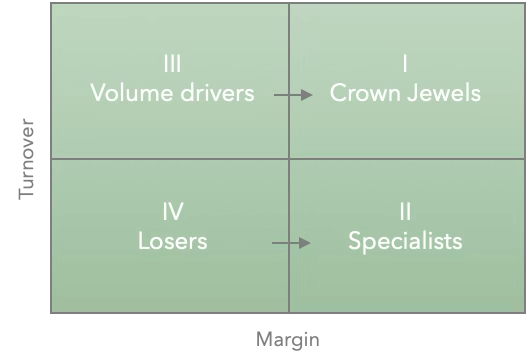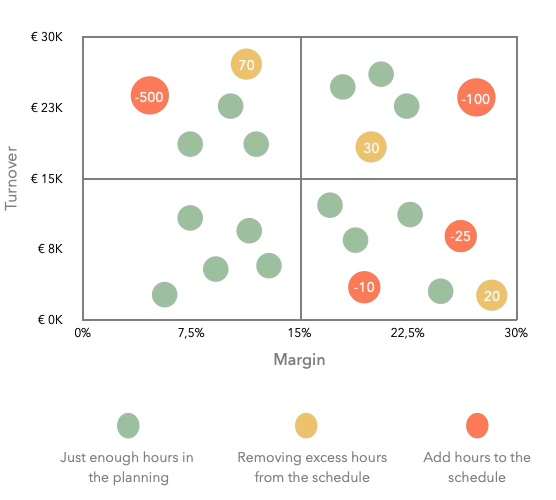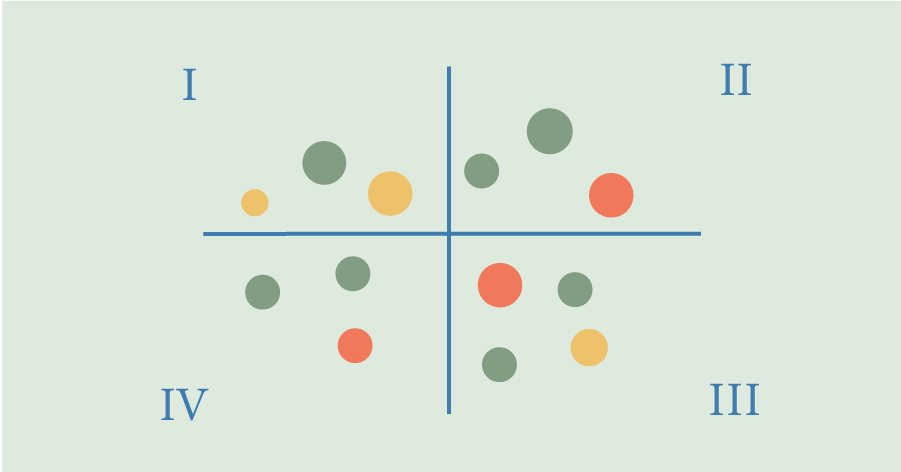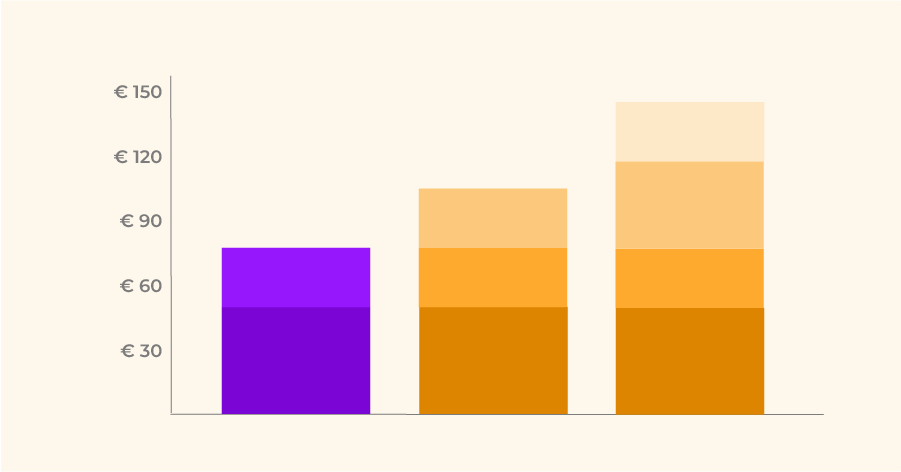As an operations manager, you’re constantly making decisions: which projects get priority, which employees to deploy where, and how to ensure healthy margins. Yet, in many organizations, these decisions are primarily made based on urgency and gut feeling. The result: too much time and energy is spent on projects that yield little, while the truly valuable projects receive insufficient attention.
Impact-led resource planning offers a solution here, as it looks beyond just hours. By planning projects not only based on capacity but also on revenue and margin, you gain immediate insight into which projects truly matter. The result? A clearer focus, better deployment of people, and greater impact.
Four quadrants that provide direction
The core of impact-led resource planning is the division of projects into four quadrants, based on two axes: revenue and margin. This model makes it immediately clear which projects have a higher priority. It also provides insight into which “lesser” projects should be addressed and moved to a different quadrant.

Figure 1: Project quadrants based on revenue and margin
I – Crown jewels
Large, high-margin projects. These are the projects you want to maximize. They deserve the most attention in your planning, because these projects will help you achieve the best business results: the highest revenue at the highest margin.
II – Specialists
Smaller, high-margin projects. If you have a lot of them, they can still generate substantial revenue. After the crown jewels, these are the projects you want to plan carefully, because they yield a good bottom line.
III – Volume Drivers
Large, low-margin projects. They generate a lot of work but impact profitability. The challenge here is to reduce expensive staff and external resources and increase efficiency. This is how they can ultimately grow into the crown jewels quadrant.
IV – Losers
Projects with low revenue and low margins deserve the least attention. If you have too many of them, it’s important to critically examine the underlying services. Do you want to continue offering these projects? If so, examine them to see how you can improve margins by lowering the cost price or raising commercial rates.
KPI: the forecast planning variance
In addition to this strategic division, impact-led resource planning also introduces an actionable KPI: the forecast planning variance. This KPI indicates how many hours are still needed to complete projects and compares this to the hours reserved in the future resource plan. It therefore reveals whether hours are missing or, conversely, too many hours have been scheduled:
- Are there too few hours? Then you have to supplement resource planning to meet deadlines.
- Are there too many hours? Then you can free up excess capacity for other projects.
- Are you exactly on target? Then you know that the balance is right and that resources have been deployed optimally.
The second scenario shouldn’t be underestimated. How often do we overschedule capacity and simply let it slide? In the worst-case scenario, the hours are simply “worked” on the project, even though they could have been spent on other strategic projects and clients.
Combining this KPI with the four quadrants creates a highly actionable dashboard. At a glance, you can see where you need to address your resource planning.

Figure 2: Bubble chart with forecast planning variance
The big advantage is that you can measure this continuously. This prevents problems from only becoming apparent at the end of a project. Instead, you can make timely adjustments.
What does this mean for operations managers?
For operations managers in sectors such as accounting, IT, technical services and consulting, impact-led resource planning means three things:
- Improved focus : You’ll know which projects truly contribute to business results. This prevents teams from wasting their energy on loss-making projects.
- Increased productivity : By measuring the KPI forecast planning variance and correcting the schedule, you maximize your capacity. No waste, no gaps.
- More strategic role : Your role shifts from firefighter to strategic advisor. You can justify why certain projects are prioritized, and this also convinces senior management and commercial teams.
But such an overview doesn’t just appear out of thin air. Resource planning first needs to be enriched with revenue and margin. At that point, you can plot the projects within the quadrants. Then, calculate the KPI for the forecast planning variance. Make this a weekly process to ensure a reliable overview.
Conclusion: focus on impact instead of busyness
Many organizations schedule primarily based on who’s available and which deadlines are the loudest. The risk is that you’re constantly busy but not making the right impact.
Impact-led resource planning turns this around. By focusing on revenue and margin and continuously measuring where capacity is truly needed, you no longer manage by capacity, but by results. For operations managers, this is the ultimate tool for gaining control over complexity while simultaneously contributing to the organization’s strategic goals.
Want to know what this looks like in your organization? Take the step towards impact-led resource planning and discover which projects truly matter.




